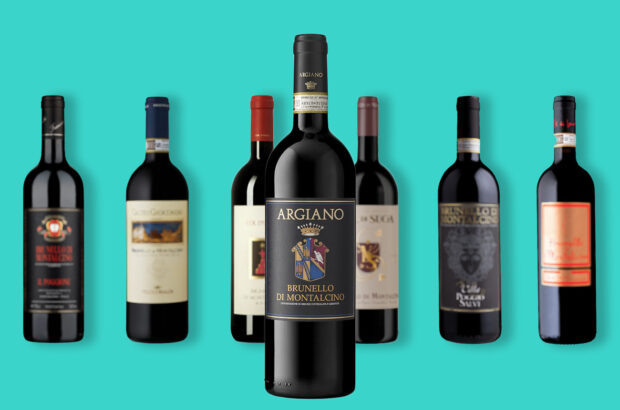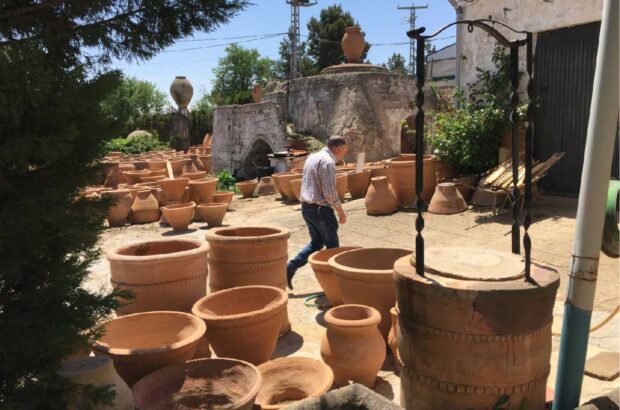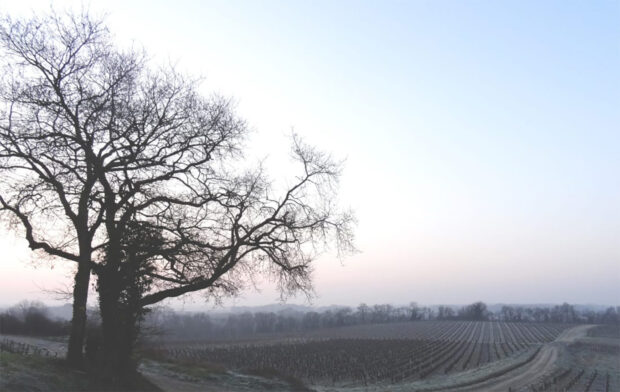- It is important in Châteauneuf to follow producer names rather than appellation names.
- ‘Too many growers are taking advantage of the market.’
- The move towards local bottling has enhanced the general quality.
- It is a story of shortage of supply, and increased demand.
For wine drinkers, the finest red wines of the Southern Rhône mean richness, spice, power and perfume. They are wines of the Mediterranean, of heat and sunshine. They are wines which appeal to wine drinkers accustomed to the rich, full-bodied tastes of Shiraz from Australia. They are attractive when relatively young, but have the ability to age for 10 or 20 years. The wine that epitomises all these characteristics comes from a small plateau-topped hill a few kilometres north of Avignon. The local landmark is the ruined wall of what was once a huge castle. Beneath this wall, a village of wine growers – every house showing some sign of viticultural activity – spreads out to the flat plain of the Rhône. This is Châteauneuf-du-Pape. It is by far the most famous appellation in the Southern Rhône. The crossed papal keys embossed on bottles (indicating that the wine has been bottled in Châteauneuf) are a reminder that this was the first appellation contrôlée region to be created in 1923, the model for the rest of the French system.
Rhône Valley
Yet, like some equally famous Burgundian appellations all has not been well with the reputation of Châteauneuf. Too much wine has left the region to be bottled by négociants in the Northern Rhône, Burgundy and Bordeaux. And even though the percentage is now down to about 40%, that still represents a lot of wine that carries the name Châteauneuf, but not necessarily the quality. Charles Blagden, who works as a courtier in the southern Rhône region explains: ‘With high worldwide demand for Châteauneuf, négociants are fighting to get the wine they need and are paying premium prices for wine in bulk – a disincentive to smaller growers to follow the bigger domaines to estate bottling and to cut yields.’
The move towards local bottling, however, has enhanced the general quality. Domaines and estates have followed a quality route, assisted by the naturally low yields in the vineyards. Local négociant firms such as Père Anselme, owned by the Brotte family, and Domaines Michel Bernard (now part of the Boisset group of Burgundy) have placed greater emphasis on domaine and vineyard bottlings.
Stylistically, though, Châteauneuf can vary widely. The range goes from the soft, early drinking wines from the local cooperative Le Cellier des Princes, to the long-lived wines of properties such as Château Rayas (owned by Emmanuel Raynaud) and Château de Beaucastel (owned by the Perrin family), to the more elegant offerings, with their new wood flavours, coming from Château la Nerthe.
Price-wise, too, the range is huge. Inexpensive négociant Châteauneuf can cost as little as £8 in the UK, while top estate wines appear at £20 or more. In other French wine regions, that difference is unlikely to appear in one single appellation. In Bordeaux, for example, the price range of an appellation like Pauillac is much narrower.
That is why it is important in Châteauneuf to follow producer names rather than appellation names. At the top of the tree, the best domaines are certainly making wines which are worthy of the name and deserve the price. And those prices compare well with other famous appellations in Bordeaux and Burgundy. ‘From good growers,’ says Blagden, ‘the wine is certainly worth the money, even though it has spiralled over the past few years due to international demand’.
There are ‘too many growers who are taking advantage of the market’, says Robin Yapp of Yapp Brothers, (importing Châteauneuf since 1971). ‘They are careless, they aren’t exercising selection over their fruit. It is these growers who are making excessive and cynical price increases.’ By contrast, he cites one producer whose wines he imports – Le Vieux Donjon – who has been ‘discovered’ by Robert Parker. There has been consequent pressure on demand and price. ‘The Michels (the owners) could have put up the price by 30% or more, especially with the great 1998, but they’ve been more modest and responsible.’ The 1998 currently sells at Yapp Brothers for £15.75, while the 1997 is £13.50.
And, with demand, comes the inevitable shortage of supply. By now, the 1998s currently being bottled, have all been sold. ‘To buy Châteauneuf today,’ a local négociant said, ‘you have to buy 1999, and most won’t be in bottle until next year.’ With a fixed vineyard area, almost entirely planted, and lowish yields due to the soil and climate, there is little chance of any serious increase in quantity.
It is a story of shortage of supply, and increased demand. Once Châteauneuf could represent terrific value for money – things have certainly changed. The better wines have found their rightful position in the wine world, as worthy competitors and alternatives to the best of the Northern Rhône or Australian Shiraz. Other wines are jumping on a bandwagon. The best are excellent value, others are definitely not.
If care needs to be exercised when buying the wines, this is no more than is usual with any appellation in France. The message, though, is that it is no longer possible to get decent Châteauneuf at bargain prices. It may be a shame, but for the growers of the papal village on the hill, it is probably right.
Top estates
Top Châteauneuf-du-Pape estates and domaines which regularly receive praise from reviewers on both sides of the Atlantic: Château de Beaucastel, Domaine de Beaurenard, Château la Gardine, Domaine la Janasse, Clos du Mont Olivet, Château Mont-Redon, Château la Nerthe, Clos des Papes, Château Rayas, Domaine de la Vieille Julienne, Domaine le Vieux Donjon, Domaine du Vieux Télégraphe.
Among the négociant bottlings of Châteanueuf, a few stand out: Chapoutier la Bernardine, Paul Jaboulet Aîné les Càdres, Domaines Michel Bernard les Domaniales.
Gigondas
If Châteauneuf-du-Pape, at its best, is the finest wine in the Southern Rhône, then Gigondas is probably the purest expression of the Southern Rhône’s premier varietal, Grenache. The wines reveal the power and the alcohol of the grape, but should also show its strength and its spicy characters.
Since it became an independent appellation in 1971, the major domaines in the village have shown a reassuring ability to increase quality. Blagden believes that ‘the quality level of Gigondas has improved over recent years more dramatically than that of Châteauneuf. Prices, while nudging the levels of Châteauneuf, are still marginally lower. And, at the lower level, the quality of basic Gigondas is better than that of basic Châteauneuf.’
There are more domaine bottlings as a percentage of total production than in Châteauneuf, always a good sign for higher quality. The Cave des Vignerons de Gigondas, the local coop has the reputation of being one of the best village coops in the Rhône, and Gigondas from the neighbouring coop of Vacqueyras is ripe and full of fruit.
The top domaines in Gigondas include Domaine les Goubert, Domaine du Cayron, Domaine Raspail-Ay,. Also Domaine Saint-Gayan, Château Trignon, as well as better cuvées from the local Mr Big, Gabriel Meffre.












